
- •Definition of economics
- •Modern definition of the subject
- •1.3 Scarcity
- •1.4.Microeconomics and Macroeconomics
- •2.1.Types of industry
- •2.2. Sectors of business
- •2.3. Classification of business
- •2.4. Forms of business
- •Forms of business
- •6.1. Field Research
- •6.2.Desk Research
- •Price of market balance: p – price, q - quantity of good, s – supply,
- •5 P rule
- •The purpose of tight fiscal policy is:
- •Side Effects of Tight Fiscal Policy
- •21.1. Law of comparative advantage
- •21.2. Absolute Advantage
- •Origin of the theory
- •Example
- •Unit 20 Balance of payments
- •Bookkeeping system
- •Foreign Exchange
- •Unit 24 Underground Economy
- •Unit 25 Preferred and Common Stocks
- •Unit 26 Economic Functions of Government
- •Unit 39 Factors of Production
- •Intrinsic
- •Need of venture capital
- •Main alternatives to venture capital
- •Basic roles
- •[Edit]Management skills
- •[Edit]Formation of the business policy
- •Levels of management
- •[Edit]Top-level managers
- •[Edit]Middle-level managers
- •[Edit]low-level managers
- •International trade
- •U nited States
Unit 39 Factors of Production
Resources required for generation of goods or services, generally classified into four major groups:
LAND - Land is the natural resources on the planet including space on the ground, seas, oceans, air etc.
LABOUR - Labor is the human input (workers, managers etc) into the production process. The UK has about 58 million people of which approximately 35 million are of working age. Each individual has a different level of skills, qualities and qualifications. This is known as HUMAN CAPITAL.
CAPITAL - Man made physical goods used to produce other goods and services. Examples: machines, computers, tools, factories, roads etc. Increases in the level of capital are called INVESTMENT
ENTERPRISE - The entrepreneur provides the initial ideas. They risk their own resources in business ventures. They also organize the other 3 factors of production.
Extra factors are:
Capital — This has many meanings, including the financial capital raised to operate and expand a business. In much of economics, however, "capital" (without any qualification) means goods that can help produce other goods in the future, the result of investment. It refers to machines, roads, factories, schools, infrastructure, and office buildings which humans have produced in order to produce goods and services.
Fixed capital — This includes machinery, factories, equipment, new technology, factories, buildings, computers, and other goods that are designed to increase the productive potential of the economy for future years. Nowadays, many consider computer software to be a form of fixed capital and it is counted as such in the National Income and Product Accounts of the United States and other countries. This type of capital does not change due to the production of the good.
Working capital — This includes the stocks of finished and semi-finished goods that will be economically consumed in the near future or will be made into a finished consumer good in the near future. These are often called inventories. The phrase "working capital" has also been used to refer to liquid assets (money) needed for immediate expenses linked to the production process (to pay salaries, invoices, taxes, interests...) Either way, the amount or nature of this type of capital usually changed during the production process.
Financial capital — This is simply the amount of money the initiator of the business has invested in it. "Financial capital" often refers to his or her net worth tied up in the business (assets minus liabilities) but the phrase often includes money borrowed from others.
Technological progress — For over a century, economists have known that capital and labor do not account for all of economic growth. This is reflected in total factor productivity and the Solow residual used in economic models called production functions that account for the contributions of capital and labor, yet have some unexplained contributor which is commonly called technological progress. Ayres and Warr (2009) present time series of the efficiency of primary energy (exergy) conversion into useful work for the US, UK, Austria and Japan revealing dramatic improvements in model accuracy. With useful work as a factor of production they are able to reproduce historical rates of economic growth with considerable precision and without recourse to exogenous and unexplained technological progress, thereby overcoming the major flaw of the Solow Theory of economic growth
UNIT 40 Free Trade
The act of opening up economies is known as "free trade" or "trade liberalization." It usually benefits the larger, wealthier countries whose big companies are looking to expand and sell their goods abroad. In the one sector where developing countries have the most to gain - agricultural goods - wealthier countries maintain the highest level of "protection" of their own markets.
Globalization has made the world a much smaller place. Global trade refers to the act of buying and selling goods and services between countries. Today these goods and services can travel further and faster so that - for instance - products from all over the world can be found at your corner shop. This can be anything from fruits and vegetables, to cars, banking services, clothing, and bottled water.
The scale and pace of this kind of trade has only increased over time, and has become a very powerful tool. International trade is considered a prime indicator of how well a country develops, and affects very much how well the economies of different countries are doing.
Features of free trade
Free trade implies the following features:
Trade of goods without taxes (including tariffs) or other trade barriers (e.g., quotas on imports or subsidies for producers)
Trade in services without taxes or other trade barriers
The absence of "trade-distorting" policies (such as taxes, subsidies, regulations, or laws) that give some firms, households, or factors of production an advantage over others
Free access to markets
Free access to market information
Inability of firms to distort markets through government-imposed monopoly or oligopoly power
UNIT 41 Fiscal Year (FY)
A fiscal year (or financial year, or sometimes budget year) is a period used for calculating annual ("yearly") financial statements in businesses and other organizations. In many jurisdictions, regulatory laws regarding accounting and taxation require such reports once per twelve months, but do not require that the period reported on constitutes a calendar year (i.e., January through December). Fiscal years vary between businesses and countries. Fiscal year may also refer to the year used for income tax reporting.
In addition, many companies find that it is convenient for purposes of comparison and for accurate stock taking to always end their fiscal year on the same day of the week, where local legislation permits. Thus some fiscal years will have 52 weeks and others 53.
In the United Kingdom, a number of major corporations that were once government owned, such as BT Group and the National Grid, continue to use the government's financial year, which ends on the last day of March, as they have found no reason to change since privatization.
Nevertheless, the fiscal year is identical to the calendar year for about 65% of publicly traded companies in the United States and for a majority of large corporations in the UK and elsewhere (with notable exceptions Australia, New Zealand and Japan).
Many universities have a fiscal year which ends during the summer, both to align (для выравнивания) the fiscal year with the school year, and because the school is normally less busy during the summer months. In the Northern hemisphere this is July in one year to June in the next year. In the southern hemisphere this is January to December of a single calendar year.
UNIT 42 HUMAN RESOURCE
H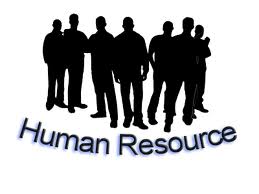 uman
resources is a term used to describe the individuals who make up the
workforce of an organization. "Human capital" refers to a
more narrow view; i.e., the knowledge the individuals embody and can
contribute to an organization.
uman
resources is a term used to describe the individuals who make up the
workforce of an organization. "Human capital" refers to a
more narrow view; i.e., the knowledge the individuals embody and can
contribute to an organization.
It is responsible for:
the attraction, selection, training, assessment, and rewarding of employees;
overseeing organizational leadership and culture;
ensuring compliance with employment and labor laws.
HR started to develop in the early 20th century. Its function used to be: to arrange transactional work such as payroll and benefits administration and partly protect employees’ rights
 HR
now focuses on strategic initiatives like mergers and acquisitions,
talent management, succession planning, industrial and labor
relations, and diversity and inclusion.
HR
now focuses on strategic initiatives like mergers and acquisitions,
talent management, succession planning, industrial and labor
relations, and diversity and inclusion.
Whereas in startup companies HR's duties may be performed by a handful of trained professionals or even by non-HR personnel, larger companies typically house an entire functional group dedicated to the discipline, with staff specializing in various HR tasks and functional leadership engaging in strategic decision making across the business. To train practitioners for the profession, institutions of higher education, professional associations, and companies themselves have created programs of study dedicated explicitly to the duties of the function. Academic and practitioner organizations likewise seek to engage and further the field of HR, as evidenced by several field-specific publications.
I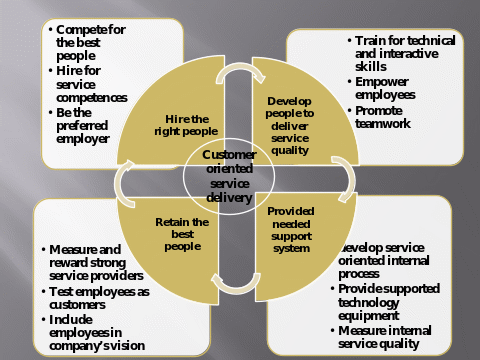 n
practice, HR is responsible for employee experience during the entire
employment lifecycle. It is first charged with attracting the right
employees through employer branding. It then must select the right
employees through the recruitment process. HR then on boards new
hires and oversees their training and development during their tenure
with the organization. HR assesses talent through use of performance
appraisals and then rewards them accordingly. In fulfillment of the
latter, HR may sometimes administer payroll and employee benefits,
although such activities are more and more being outsourced, with HR
playing a more strategic role.
n
practice, HR is responsible for employee experience during the entire
employment lifecycle. It is first charged with attracting the right
employees through employer branding. It then must select the right
employees through the recruitment process. HR then on boards new
hires and oversees their training and development during their tenure
with the organization. HR assesses talent through use of performance
appraisals and then rewards them accordingly. In fulfillment of the
latter, HR may sometimes administer payroll and employee benefits,
although such activities are more and more being outsourced, with HR
playing a more strategic role.
At the macro-level, HR is in charge of overseeing organizational leadership and culture. HR also ensures compliance with employment and labor laws, which differ by geography, and often oversees health, safety, and security. In circumstances where employees desire and are legally authorized to hold a collective bargaining agreement, HR will typically also serve as the company's primary liaison with the employees' representatives (usually a labor union). Consequently, HR, usually through industry representatives, engages in lobbying efforts with governmental agencies (e.g., in the United States, the United States Department of Labor and the National Labor Relations Board) to further its priorities.
The discipline may also engage in mobility management, especially pertaining to expatriates; and it is frequently involved in the merger and acquisition process. HR is generally viewed as a support function to the business, helping to minimize costs and reduce risk.
Questions to unit 42
What is human resource?
What is human capital?
What is human resources responsible for?
On the example of customer oriented service delivery explain how the human resource work.
U NIT
43 BUSINESS
CORRESPONDENCE
NIT
43 BUSINESS
CORRESPONDENCE
The functions of non-verbal communication
• To provide information, either consciously or unconsciously
• To regulate the flow of conversation
• To express emotion
• To qualify, complement, contradict, or expand verbal messages
• To control or influence others
• To facilitate specific tasks
To make letters understandable:
U
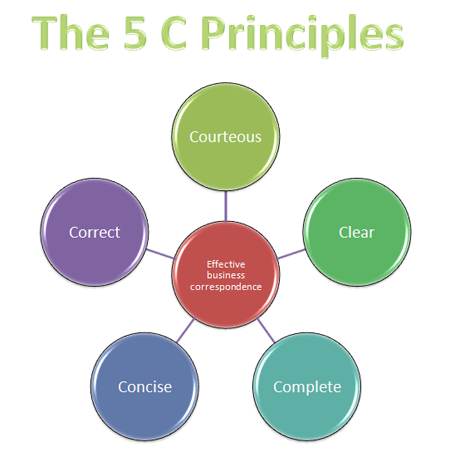 se
short, precise words that say exactly what you mean.
se
short, precise words that say exactly what you mean.Rely on specific terms to explain your points. Avoid abstractions altogether, or illustrate them with concrete examples.
Construct sentences that are shorter and simpler than those you might use when writing to someone fluent in English.
Stay away from slang, jargon, and buzz words. Such words rarely translate well. Nor do idioms and figurative expressions. Abbreviations, tscfo-nyms (such as NOKAI) and CAD/CAM), and North American product names may also lead to confusion
Use short paragraphs. Each paragraph should stick to one topic and be no more than eight to ten lines.
Use numbers, visual aids, and pre-printed forms to clarify your message. These devices are generally understood in most cultures.
Your word choice should also reflect the relationship between you and the reader.
Help readers follow your train of thought by using transitional devices. Precede related points with expressions like in addition and first, second, third.
Types of Business Correspondence
Correspondence on social situations
Invitations: Accepting and Declining
Appointments and Travel Arrangements
Goodwill letters: Congratulations, Introductions, Condolence, Christmas and New Year Wishes
Thanks for Hospitality, Requests
Employment: Applications,
Letters of Recommendation, Giving notice
Correspondence on business situations
1. Inquiries
An inquiry (also spelt enquiry) is sent when a businessman wants some information, especially about
· the supply of goods
· leaflets or catalogues
· quotation or prices
· samples
· terms and discounts
· availability of goods
· delivery times and deadlines
· method of transport
· insurance
2. Quotations. Offers
The quotation in reply to an inquiry may be a simple one, containing simply the prices and other information asked for. The sales-conscious businessman, however, will take the opportunity to stimulate his correspondent's interest in his goods or services by including a sales message and the assurance that the customer will receive personal attention.
Offers are also sent without a preceding inquiry when a supplier wants to draw the attention of customers and new customers to a special product or range of goods. A firm offer is subject to certain conditions, a deadline for the receipt of orders, or a special price for certain quantities.
3. Sales Letters
Direct advertising, in the form of letters to a selected group of readers, is an effective way to promote sales. Such sales letters should appeal to the potential customer. They should:
· arouse the reader's attention
· create desire to make use of your offer
· convince him that these products or services are the best ones for him
· activate him to place an order
4. Counter-Proposals, Concessions
A buyer need not accept the prices and terms offered by the seller unconditionally. There will often be good reason to make a counter-proposal with the object of obtaining better prices or terms, or a shorter time of delivery. As a result of these negotiations, the supplier could make a concession, particularly for an introductory sale, or if the customer places a large order.
Per pro
The term 'per pro' (p.p.) is sometimes used in signatures and means 'for and on behalf of'. Secretaries sometimes use p.p. when signing a letter on behalf of their bosses.
When writing on behalf of your company, it is useful to indicate your position in the firm in the signature.
Enclosures
If there are many enclosures, e.g. leaflets, prospectus, etc., with the letter, these may be mentioned in the body of the letter. But many firms in any case write Enc. or Encl. At the bottom of the letter, and if there are a number of documents, these are listed, e.g.
Enc.
Bill of landing (5copies)
Insurance certificate (1 copy)
Bill of exchange (1 copy)
'Private and confidential'
This phrase may be written at the head of a letter above salutation, and more importantly on the envelope, in cases where the letter is intended only for ht eyes of the named recipient.
Copies
· c.c. (= carbon copies) is written, usually at the end of the letter, when copies are sent to people other than the named recipient.
· b.c.c. (=blind carbon copies) is written at the copies themselves, though not, on the top copy, when you do not want the named recipient to know that other people have received the copies as well.
Technical layout of letter:
1.Letterhead:
This will include your company's name, address, telephone number, fax number and email address. Include your web address if available. Other information may be required depending on the legal status of your business formation. Contact your legal adviser for exact details.
2. Name and address:
Always include the recipient's name, address and postage code. Add job title if approriate. Double check that you have the correct spelling of the recipient 's name .
3.Date:
Always date your letters.Never abbreviate January to Jan. 31.
4.Reference:
These are optional. They are a good idea if you have a large volume of correspondence. These day modern word processors made this an easy task to complete and maintain.
5.Salutations:
The type of salutation depends on your relationship with the recipient. Always try to personalise letter thus avoiding the dear sir/madam situation.
6.Subject matter:
Again this is optional, but its inclusion can help the recipient in dealing successfully with the aims of your letter. Normally the subject sentence is preceded with the word Re: It should be placed one line below the greeting.
7.Communication:
This will contain a number of paragraphs, each paragraph dealing with one point and one point only.
8.Signature:
The signature should be clear and legible-showing you are interested in the letter and consequently the recipient.Your signature should also be followed underneath by a typed version of your name and your job title.
9.Enclosures:
If you include other material in the letter, put 'Enclosure','Enc', or' Encs', as appropriate, two lines below the last entry.
UNIT 44 LOCAL FINANCE
L ocal
finance is a system of economic relations, where national income are
distributed and redistributed for economic and social development
area.
ocal
finance is a system of economic relations, where national income are
distributed and redistributed for economic and social development
area.
Effective functioning of local government is associated with performing the assigned and delegated functions Among them - ensuring the public interest and needs at the local level, promoting social and economic development areas. Fulfillment of mentioned tasks requires the relevant financial resources.
According to the definition of O. D. Vasylyk "local finances is a set of forms and methods of creating funds of financial resources for carrying out the functions in the field of economic and social development by local authorities
Functions of Local Finance |
|||
Distribution and redistribution of GDP |
Formation of fiscal policy at the local level |
Funding of public services |
Economic growth areas |
In Ukraine, forms of local finance are finance of local community (public finance), finance of Autonomous Republic of Crimea, regional finance, finance cities of Kyiv and Sebastopol city finances, finance of district, region, in the city, village finances.





The main subject of local finance in Ukraine is the local community and local government. In other countries the main subjects of financial relations in the field of local finance is the municipalities, communes, regions, departments, provinces, regions, districts and other administrative-territorial units.
The objects of local finance are the financial resources used by local authorities to carry out the functions and tasks.
The main financial funds of local government are: the local budgets, reserve, currency and off-budget trust funds, funds of cash resources, utilities and others. Local authorities can also make financial resources by obtaining bank loans, issuing of municipal loans
Questions to the Unit:
;
UNIT 45 FINANCIAL ANALYSES
Financial analysis (also referred to as financial statement analysis or accounting analysis) refers to an assessment of the viability, stability and profitability of a business, sub-business or project.
It is performed by professionals who prepare reports using ratios that make use of information taken from financial statements and other reports. These reports are usually presented to top management as one of their bases in making business decisions.
Continue or discontinue its main operation or part of its business;
Make or purchase certain materials in the manufacture of its product;
Acquire or rent/lease certain machineries and equipment in the production of its goods;
Issue stocks or negotiate for a bank loan to increase its working capital;
Make decisions regarding investing or lending capital;
Other decisions that allow management to make an informed selection on various alternatives in the conduct of its business.
GOALS
Financial analysts often assess the firm's:
1. Profitability -its ability to earn income and sustain growth in both short-term and long-term. A company's degree of profitability is usually based on the income statement, which reports on the company's results of operations;
2. Solvency - its ability to pay its obligation to creditors and other third parties in the long-term;
3. Liquidity - its ability to maintain positive cash flow, while satisfying immediate obligations;
Both 2 and 3 are based on the company's balance sheet, which indicates the financial condition of a business as of a given point in time.
4. Stability- the firm's ability to remain in business in the long run, without having to sustain significant losses in the conduct of its business. Assessing a company's stability requires the use of both the income statement and the balance sheet, as well as other financial and non-financial indicators
UNIT 46 Japanese Phenomenon
Levels in business structure
"Keyey" (directors) - the highest level of strategic management. It includes the post of chairman and members of the board of directors, president, vice presidents and heads of central services. At this level strategic goals and company policy are defined.
2. "Kanry" (administration) - average tactical level. It includes positions of heads of company’s departments.
3. "Ippan" (workers) - the operational level of management. This level includes positions of line managers: masters and team leaders.
J apanese
management system
apanese
management system
Aspects of Japanese management
highly centralized management
coordination of all hierarchical links
there is no competition between individual workers
three-tiered management structure, which is the most mobile
labor discipline is the foundation of the Japanese phenomenon
Each Japanese company is a pyramid, which consists of a large number of small groups
UNIT 47 COMPANY STRUCTURE
Matrix structure
A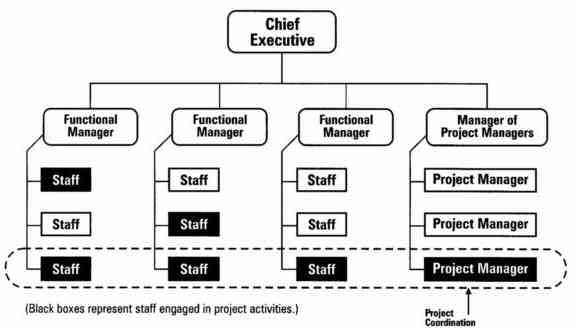 matrix organization structure is an organizational reporting
structure commonly used for project-based teams. It groups teams in
the organization by both their department and their product, allowing
for ideas to be exchanged between varying parts of the organization.
matrix organization structure is an organizational reporting
structure commonly used for project-based teams. It groups teams in
the organization by both their department and their product, allowing
for ideas to be exchanged between varying parts of the organization.
Matrix structure is defined as a type of management system in which workers report to more than one person, effectively having two or more supervisors at the same time.
Matrix structure |
|
Advantages: |
Disadvantages |
Conflicts between staff are minimal There is a better balance between time, cost and performance Authority and responsibility are shared Stress is distributed among the team |
Misunderstanding from dual chain of command Conflicts between two sides of the matrix A lot of meetings and discussions Human relations skills needed Out-of-date and costly method |
The matrix structure first evolved during a project developed by NASA when they needed to pool together different skills from a variety of functional areas.
Now this type of structure is used at Procter &Gamble, Harvard Business School and other
Even though the matrix structure has some disadvantages, matrix organizations provide clear accountability within a specific business function and allow more efficient allocation of specialized skills across the entire business.
Functional Structure
E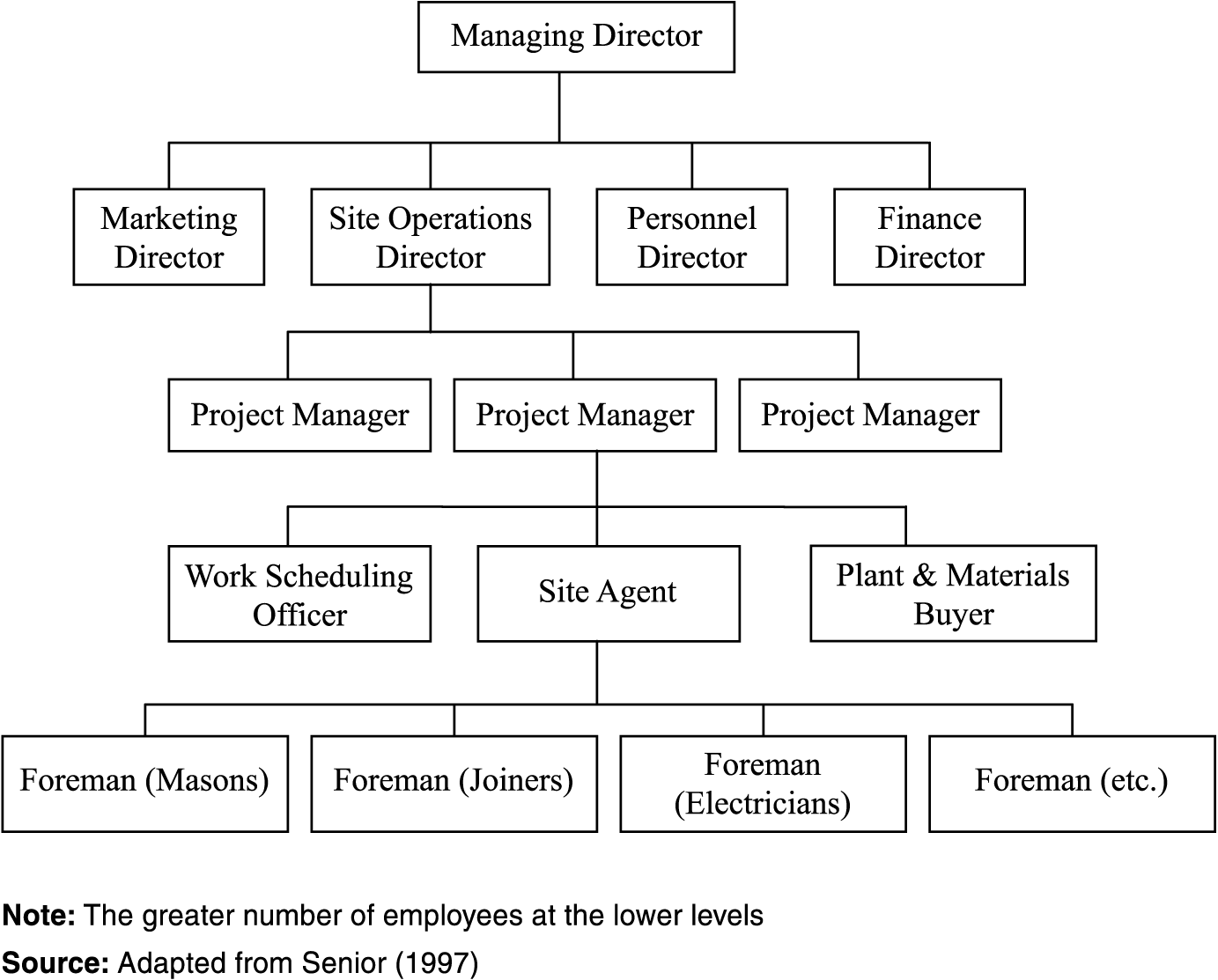 mployees
within the functional divisions of an organization tend to perform a
specialized set of tasks, for instance the engineering department
would be staffed only with software engineers. This leads to
operational efficiencies within that group. However it could also
lead to a lack of communication between the functional groups within
an organization, making the organization slow and inflexible.
mployees
within the functional divisions of an organization tend to perform a
specialized set of tasks, for instance the engineering department
would be staffed only with software engineers. This leads to
operational efficiencies within that group. However it could also
lead to a lack of communication between the functional groups within
an organization, making the organization slow and inflexible.
As a whole, a functional organization is best suited as a producer of standardized goods and services at large volume and low cost. Coordination and specialization of tasks are centralized in a functional structure, which makes producing a limited amount of products or services efficient and predictable. Moreover, efficiencies can further be realized as functional organizations integrate their activities vertically so that products are sold and distributed quickly and at low cost.[11] For instance, a small business could make components used in production of its products instead of buying them. This benefits the organization and employees faiths.
Functional Structure |
|
Advantages: |
Disadvantages: |
the high competence of the specialists standardization and the programming of the processes maximizes functional performance |
slow response poor accountability restrictive possibilities of units \ |
Product Line Structure
More and more companies are organizing themselves along product lines where companies have separate divisions according to the product that is being worked on. in this case the focus is always on the product and how it can be improved.
A product structure will divide an organization into divisions in charge for different products. This structure will be used by those companies which produce more than one product.
Tasks can also be grouped according to a specific product or service, thus placing all activities related to the product or the service under one manager. Each major product area in the corporation is under the authority of a senior manager who is specialist in, and is responsible for, everything related to the product line.
Product structure groups employees together based upon specific products produced by the company.
An example of this would be a company that produces two distinct products, "product I" and "product II". This company would have a separate division for each product.
Product line structure |
|
Advantages: |
Disadvantages: |
focusing upon a single product or service receiving the necessary resources from the company specialized and fundamental knowledge and skills of workers more autonomous divisions |
competition between different divisions
|
Geographic Structure
Geographic structure is a term that refers to organizing an international company based on the area in which it operates; each area is responsible for operations in that area, while the corporate office directs global strategy.
Regional Divisions
Under a global geographic structure, products are handled by regional divisions, which can adapt more readily to local cultures, regulations, economies and preferences. A geographic structure is essential in developing local contacts, according to "International Business" by Oded Shenkar and Yadong Luo.
Growth Potential
At one time, a geographic structure was more effective for established businesses with more limited and stable product lines, but companies with a variety of faster changing products also benefit from a geographic structure.
Examples
Examples of companies that can benefit from a global structure are large manufacturers of electronic devices which are used worldwide but are subject to different regulations and consumer preferences. Food manufacturers must also tailor their products to cultural and regional preferences.
Questions to Unit Company Structure
What kinds of company structure do you know?
What are the advantages of matrix structure?
What are the disadvantages of functional structure?
Give the characteristic to the product line structure.
Compare matrix and functional structure for Ukrainian manufacturing companies.
What is the main peculiarity of geographic structure of the company?
What are the advantages of functional structure?
What growth potential is there in geographic structure?
What company structure is more effective for:
career growth of the employees;
strong centralized control
developing of team working skills?
UNIT 48 INFLATION
I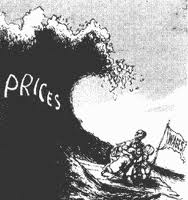 nflation
also reflects an erosion in the purchasing power of money – a loss
of real value in the internal medium of exchange and unit of account
in the economy
nflation
also reflects an erosion in the purchasing power of money – a loss
of real value in the internal medium of exchange and unit of account
in the economy
The inflation has positive and negative influence on economics development.
Positive effects include ensuring central banks can adjust nominal interest rates (intended to mitigate recessions), and encouraging investment in non-monetary capital projects
N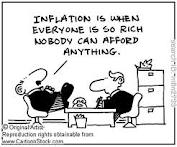 egative
effects
of inflation include a decrease in the real value of money and other
monetary items over time, uncertainty over future inflation may
discourage investment and savings, and high inflation may lead to
shortages of goods if consumers begin hoarding out of concern that
prices will increase in the future
egative
effects
of inflation include a decrease in the real value of money and other
monetary items over time, uncertainty over future inflation may
discourage investment and savings, and high inflation may lead to
shortages of goods if consumers begin hoarding out of concern that
prices will increase in the future
There are such types of inflation:
Creeping inflation is the process of prices’ increasing less than 10% per year
Galloping inflation is the process of prices’ increasing from 10 to 50% per year
Hyper inflation is increasing prices in many times
An increase in the money supply may be called monetary inflation, to distinguish it from rising prices, which may also for clarity be called 'price inflation'.
Economists generally agree that in the long run, inflation is caused by increases in the money supply. However, in the short and medium term, inflation is largely dependent on supply and demand pressures in the economy
Inflation is usually estimated by calculating the inflation rate of a price index, usually the Consumer Price Index. The Consumer Price Index measures prices of a selection of goods and services purchased by a "typical consumer“. The inflation rate is the percentage rate of change of a price index over time
Consumer price index
A consumer price index (CPI) measures changes in the price level of consumer goods and services purchased by households. The CPI, in the United States is defined by the Bureau of Labor Statistics as "a measure of the average change over time in the prices paid by urban consumers for a market basket of consumer goods and services."
The CPI is a statistical estimate constructed using the prices of a sample of representative items whose prices are collected periodically. Sub-indexes and sub-sub-indexes are computed for different categories and sub-categories of goods and services, being combined to produce the overall index with weights reflecting their shares in the total of the consumer expenditures covered by the index. It is one of several price indices calculated by most national statistical agencies. The annual percentage change in a CPI is used as a measure of inflation. A CPI can be used to index (i.e., adjust for the effect of inflation) the real value of wages, salaries, pensions, for regulating prices and for deflating monetary magnitudes to show changes in real values. In most countries, the CPI is, along with the population census and the USA National Income and Product Accounts, one of the most closely watched national economic statistics.
Questions to Unit 48
What is inflation?
What type of inflation do you know?
What effects of the inflations are there?
Explain the positive effect of the inflation?
What is CPI? What is its role in the inflation?
UNIT 49 INFORMATION AGE
The Information Age, also commonly known as the Computer Age or Digital Age, is an idea that the current age will be characterized by the ability of individuals to transfer information freely, and to have instant access to information that would have been difficult or impossible to find previously. The idea is linked to the concept of a digital age or digital revolution, and carries the ramifications of a shift from traditional industry that the industrial revolution brought through industrialization, to an economy based on the manipulation of information, i.e., an information society. The Information Age formed by capitalizing on the computer microminiaturization advances, with a transition spanning from the advent of the personal computer in the late 1970s to the internet's reaching a critical mass in the early 1990s, and the adoption of such technology by the public in the two decades after 1990. Bringing about a fast evolution of technology in daily life, as well as of educational life style, the Information Age has allowed rapid global communications and networking to shape modern society.
E-mail marketing: Permission, Privacy, Profiling, Personalization.
Permission Stefan Eyram explains
"Permission is the real key to successful email marketing. If you don’t have explicit permission to send an email to a recipient you are SPAMMING them.." Eyram suggests that if companies send too much spam, lawmakers will come down hard and make regulations forbidding this, and, or people will get so tired of spam they won't take email seriously anymore .. Eyram calls this "email fatigue"
Privacy Eyram wisely advises "In the past, many email marketers have bundled the privacy issue together with permission. But Permission is a request to receive personal information and an invitation to market products or services to individual consumers.
Privacy is what email marketers do with the personal information once they receive it and how they keep it private from prying eyes. With identity theft increasing and the average person more concerned about privacy issues, those organizations that consistently take the privacy high road will endear themselves to customers."
Profiling Eyram suggests
"Keeping profiles simple is often the best rule of thumb. Essentially, marketers want to know who they are, what they want, how they want to be contacted and how often. It’s also prudent to provide end-users with access to view and freely update their profile. Putting control in the hands of the end-user is far better that having them unsubscribe from your emails because you sent them something they did not want to receive.
The smart marketer uses contests, questionnaires and polls to collect information and then aggregates the data with other sources (e.g. point-of-sale, order history, web logs, email metrics, etc.) to create powerful customer and prospect profiles."
Personalization Eyram cautions "Personalization doesn’t mean sending the same message to your entire database and changing the opening line with “Dear ” In email marketing there is no “one size fits all.” Email marketing provides you with the capability to ensure that each person gets “personal” treatment from your organization. Experience has shown us that email marketers using personalization tend to have better open and response rates. They also have an easier time keeping the end user’s permission. In the end, the combination of permission, privacy, profiling and personalization will keep end users “hooked” on your company, your products and services, your messages and your future success."
UNIT 50 Monopoly
A monopoly (from Greek monos (alone or single) + polein (to sell) exists when a specific person or enterprise is the only supplier of a particular commodity.
A situation in which a single
company
owns
all or nearly all of the market
for a given type of product
or service.
This would happen in the case that there is a barrier
to entry into the industry
that allows the single company to operate
without competition
(for example, vast economies
of scale,
barriers
to entry,
or governmental regulation).
In such an industry structure,
the producer
will often produce a volume
that is less than the amount
which would maximize social welfare.
Monopolies are thus characterized by a lack of economic competition
to produce the good
or service
and a lack of viable substitute
goods.
The verb "monopolize" refers to the process
by which a company gains much greater market share than what is
expected with perfect
competition.
situation in which a single
company
owns
all or nearly all of the market
for a given type of product
or service.
This would happen in the case that there is a barrier
to entry into the industry
that allows the single company to operate
without competition
(for example, vast economies
of scale,
barriers
to entry,
or governmental regulation).
In such an industry structure,
the producer
will often produce a volume
that is less than the amount
which would maximize social welfare.
Monopolies are thus characterized by a lack of economic competition
to produce the good
or service
and a lack of viable substitute
goods.
The verb "monopolize" refers to the process
by which a company gains much greater market share than what is
expected with perfect
competition.
Market structures
In economics, the idea of monopoly is important for the study of market structures, which directly concerns normative aspects of economic competition, and provides the basis for topics such as industrial organization and economics of regulation. There are four basic types of market structures by traditional economic analysis: perfect competition, monopolistic competition, oligopoly and monopoly. A monopoly is a market structure in which a single supplier produces and sells a given product. If there is a single seller in a certain industry and there are not any close substitutes for the product, then the market structure is that of a "pure monopoly". Sometimes, there are many sellers in an industry and/or there exist many close substitutes for the goods being produced, but nevertheless companies retain some market power. This is termed monopolistic competition, whereas by oligopoly the companies interact strategically.
In general, the main results from this theory compare price-fixing methods across market structures, analyze the effect of a certain structure on welfare, and vary technological/demand assumptions in order to assess the consequences for an abstract model of society. Most economic textbooks follow the practice of carefully explaining the perfect competition model, only because of its usefulness to understand "departures" from it (the so-called imperfect competition models).
The boundaries of what constitutes a market and what doesn't are relevant distinctions to make in economic analysis. In a general equilibrium context, a good is a specific concept entangling geographical and time-related characteristics (grapes sold during October 2009 in Moscow is a different good from grapes sold during October 2009 in New York). Most studies of market structure relax a little their definition of a good, allowing for more flexibility at the identification of substitute-goods. Therefore, one can find an economic analysis of the market of grapes in Russia, for example, which is not a market in the strict sense of general equilibrium theory monopoly.
|
Characteristics |
Explanation |
|
Profit Maximiser |
Maximizes profits. |
|
Price Maker |
Decides the price of the good or product to be sold. |
|
High Barriers to Entry: |
Other sellers are unable to enter the market of the monopoly. |
|
Single seller: |
In a monopoly there is one seller of the good which produces all the output. Therefore, the whole market is being served by a single company, and for practical purposes, the company is the same as the industry |
|
Price Discrimination: |
A monopolist can change the price and quality of the product. He sells more quantities charging less price for the product in a very elastic market and sells less quantities charging high price in a less elastic market. |
Sources of monopoly power
Monopolies derive their market power from barriers to entry – circumstances that prevent or greatly impede a potential competitor's ability to compete in a market. There are three major types of barriers to entry; economic, legal and deliberate.[4]
Economic barriers: Economic barriers include economies of scale, capital requirements, cost advantages and technological superiority.[5]
Economies of scale: Monopolies are characterised by decreasing costs for a relatively large range of production.[6] Decreasing costs coupled with large initial costs give monopolies an advantage over would-be competitors. Monopolies are often in a position to reduce prices below a new entrant's operating costs and thereby prevent them from continuing to compete.[6] Furthermore, the size of the industry relative to the minimum efficient scale may limit the number of companies that can effectively compete within the industry. If for example the industry is large enough to support one company of minimum efficient scale then other companies entering the industry will operate at a size that is less than MES, meaning that these companies cannot produce at an average cost that is competitive with the dominant company. Finally, if long-term average cost is constantly decreasing, the least cost method to provide a good or service is by a single company.[7]
Capital requirements: Production processes that require large investments of capital, or large research and development costs or substantial sunk costs limit the number of companies in an industry.[8] Large fixed costs also make it difficult for a small company to enter an industry and expand.[9]
Technological superiority: A monopoly may be better able to acquire, integrate and use the best possible technology in producing its goods while entrants do not have the size or finances to use the best available technology.[6] One large company can sometimes produce goods cheaper than several small companies.[10]
No substitute goods: A monopoly sells a good for which there is no close substitute. The absence of substitutes makes the demand for the good relatively inelastic enabling monopolies to extract positive profits.
Control of natural resources: A prime source of monopoly power is the control of resources that are critical to the production of a final good.
Network externalities: The use of a product by a person can affect the value of that product to other people. This is the network effect. There is a direct relationship between the proportion of people using a product and the demand for that product. In other words the more people who are using a product the greater the probability of any individual starting to use the product. This effect accounts for fads and fashion trends.[11] It also can play a crucial role in the development or acquisition of market power. The most famous current example is the market dominance of the Microsoft operating system in personal computers.
Legal barriers: Legal rights can provide opportunity to monopolise the market of a good. Intellectual property rights, including patents and copyrights, give a monopolist exclusive control of the production and selling of certain goods. Property rights may give a company exclusive control of the materials necessary to produce a good.
Deliberate actions: A company wanting to monopolise a market may engage in various types of deliberate action to exclude competitors or eliminate competition. Such actions include collusion, lobbying governmental authorities, and force (see anti-competitive practices).
In addition to barriers to entry and competition, barriers to exit may be a source of market power. Barriers to exit are market conditions that make it difficult or expensive for a company to end its involvement with a market. Great liquidation costs are a primary barrier for exiting.[12] Market exit and shutdown are separate events. The decision whether to shut down or operate is not affected by exit barriers. A company will shut down if price falls below minimum average variable costs.
UNIT 51 E-BUSINESS
E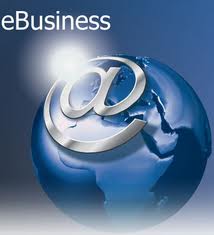 lectronic
business
"e-business",
is defined as the application of information and communication
technologies (ICT)
in support of all the activities of business. Commerce constitutes
the exchange of products and services between businesses, groups and
individuals and can be seen as one of the essential activities of any
business. Electronic commerce focuses on the use of ICT to enable the
external activities and relationships of the business with
individuals, groups and other businesses.
lectronic
business
"e-business",
is defined as the application of information and communication
technologies (ICT)
in support of all the activities of business. Commerce constitutes
the exchange of products and services between businesses, groups and
individuals and can be seen as one of the essential activities of any
business. Electronic commerce focuses on the use of ICT to enable the
external activities and relationships of the business with
individuals, groups and other businesses.
Why E-business?
Business and technology are now inextricably linked. There are no technology decisions that are not business decisions, and there are no business decisions today that don't involve technology, according to Jim Cassidy, IBM's Director Asia-Pacific.
Opportunities of e-business:
developing flexible infrastructure enabling your organization to meet the challenges of ever-changing business models;
reducing supply chain and administrative cost;
improving customer service;
d
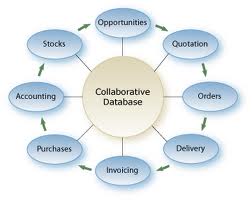 eveloping
effective and efficient market programs
eveloping
effective and efficient market programs
Business processes must not only incorporate timely company information – for improved customer relationship management, supply chain management, and beyond, they must also be kept up-to-date with fast-changing business needs. E-business facilitating these processes is the way most business soon will be transacted. Whether or not you ever plan to sell products or services over the Web, your most important customer or supplier may one day insist upon using Web for all transaction.
T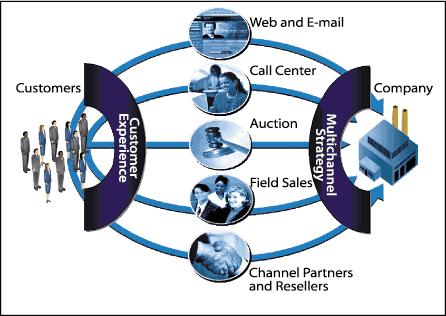 he fastest
growing companies are
moving aggressively to bring e-business into all their operations.
They align their systems with their fast-changing business priorities
and use these systems strategically, for growth. In addition,
successful businesses are employing information technology to gather
and interpret data about their ultimate customers, including
demographics, trends, and buying behavior.
he fastest
growing companies are
moving aggressively to bring e-business into all their operations.
They align their systems with their fast-changing business priorities
and use these systems strategically, for growth. In addition,
successful businesses are employing information technology to gather
and interpret data about their ultimate customers, including
demographics, trends, and buying behavior.
History
Forms of e – business were born in the 1980s. By the end of 2000, many European and American business companies offered their services through the World Wide Web. Since then people began to associate a word "e- business" with the ability of purchasing various goods through the Internet using secure protocols and electronic payment services.
Advantages of E – business : |
Disadvantages of e-business |
||
for organizations |
for costumers |
for organizations |
for customers |
Global scale Reduce of costs Improving the supply chain Business is always open Personalization |
Ubiquity Anonymity Large selection of goods and services Personalization Cheaper products and services Prompt delivery E-socialization |
Possible concerns of the parties regarding whether a project for the company (negative anonymity) Some of the difficulty in maintaining and legitimizing the activities of the enterprise on the Internet
|
Distrust of the consumer to the services sold via Internet Inability to "touch" the goods handed
|
5 years ago the Ukrainian market of e-business showed an annual growth rate of 50% -60%. For example, in Germany, the market capacity of e-business is about $ 36 billion ,in the Ukraine the same period has no more than $ 400 - $ 500 million. This market has great potential.
Questions to Unit
F
F
5
G
Y
y
UNIT 52 MOTIVATION
M otivation
is a term that refers to a process that elicits, controls, and
sustains certain behaviors. For instance: An individual has not
eaten, he or she feels hungry, as a response he or she eats and
diminishes feelings of hunger. According to various theories,
motivation may be rooted in a basic need to minimize physical pain
and maximize pleasure, or it may include specific needs such as
eating and resting, or a desired object, goal, state of being, ideal,
or it may be attributed to less-apparent reasons such as altruism,
selfishness, morality, or avoiding mortality.
otivation
is a term that refers to a process that elicits, controls, and
sustains certain behaviors. For instance: An individual has not
eaten, he or she feels hungry, as a response he or she eats and
diminishes feelings of hunger. According to various theories,
motivation may be rooted in a basic need to minimize physical pain
and maximize pleasure, or it may include specific needs such as
eating and resting, or a desired object, goal, state of being, ideal,
or it may be attributed to less-apparent reasons such as altruism,
selfishness, morality, or avoiding mortality.
Motivation



